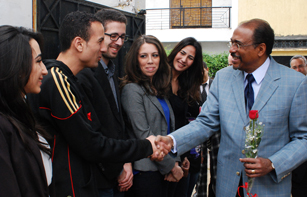
UNAIDS Executive Director Michel Sidibé (right) met with a group of young Moroccans on 4 April at the national headquarters of OPALS in Rabat.
Speaking with a group of young Moroccans on 4 April, UNAIDS Executive Director Michel Sidibé urged youth across the country—and region—to break the silence on AIDS and lead a revolution in HIV prevention.
“Young people were at the forefront of revolutions that brought political change to this region. I urge youth to launch a similar movement to stop new HIV infections,” said Mr Sidibé, addressing a group of young people at the national headquarters of OPALS (Organisation Pan Africaine de Lutte contre le sida), a non-profit organization based in Rabat.
Over the past decade, the number of new HIV infections among adults and children in the Middle East and North Africa increased from 43 000 to 59 000, according to UNAIDS estimates. In 2010, there were an estimated 470 000 people in the region living with HIV, up from 320 000 in 2001.
During the meeting, Mr Sidibé expressed concern over widespread stigma and discrimination in the region against people living with HIV and populations at high risk of infection, including sex workers, people who inject drugs and men who have sex with men. He noted that stigma drives vulnerable populations underground and away from HIV and health services.
Young people were at the forefront of revolutions that brought political change to this region. I urge youth to launch a similar movement to stop new HIV infections
UNAIDS Executive Director Michel Sidibé
Across the region, the special needs of youth—particularly sex workers, people who inject drugs, men who have sex with men and people living with HIV—remain inadequately addressed, noted the UNAIDS Executive Director. He underscored the importance of empowering all young people with the knowledge and resources they need to lead a healthy sexual lifestyle.
Through 17 drop-in clinics, OPALS provides health services, access to condoms and HIV testing for young people, women, migrants, sex workers and other vulnerable populations in Morocco. Representatives from OPALS also travel in remote areas, providing door-to-door HIV testing and other prevention services.
In the meeting with Mr Sidibé, several young people highlighted the lack of sexual education in Morocco—both at school and within families. They expressed enthusiasm for UNAIDS’ youth-led policy project CrowdOutAIDS, which leverages new technologies to enable young people to fully participate in the development of the organization’s strategy on HIV and youth. Since the launch of the project in October 2011, some 5000 young people around the world have taken part.
Reaching most-at-risk populations
During his three-day mission to Morocco, Mr Sidibé paid a visit to the Association de Lutte contre le sida (ALCS) in Rabat, the first AIDS association established in the Maghreb region and the Middle East. Mr Sidibé praised Hakima Himmich, President of ALCS, and her staff for the organization’s excellent contribution to the HIV response—particularly its efforts to prevent HIV among populations at high risk of infection.
ALCS was established in 1998 when there were just 30 registered cases of AIDS in Morocco. In 1992, ALCS opened its first voluntary HIV testing and counselling centre, and since 1995, the organization has offered HIV prevention programmes for key populations at high risk of infection.
By 2011, more than 122 000 people at high risk of infection—including vulnerable and bridge populations (for example, clients of sex workers)—were benefiting from HIV prevention programmes in Morocco, largely through ALCS. That same year, an estimated 58 000 people in Morocco were tested for HIV, many of them through ALCS.
According to studies conducted in 2011 by Morocco’s National AIDS Programme, ALCS and UNAIDS, 45% of sex workers and men who have sex with men in the country are currently reached through HIV prevention programmes and the rate of condom use among these key populations is about 50%.
During his visit to ALCS, Mr Sidibé sat in on a group discussion with women focused on HIV prevention. He also met a peer support group for people living with HIV and spoke with health personnel at an HIV testing centre.




